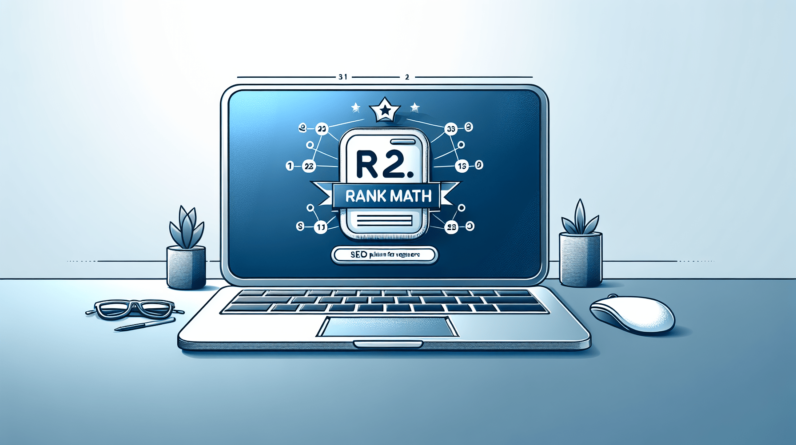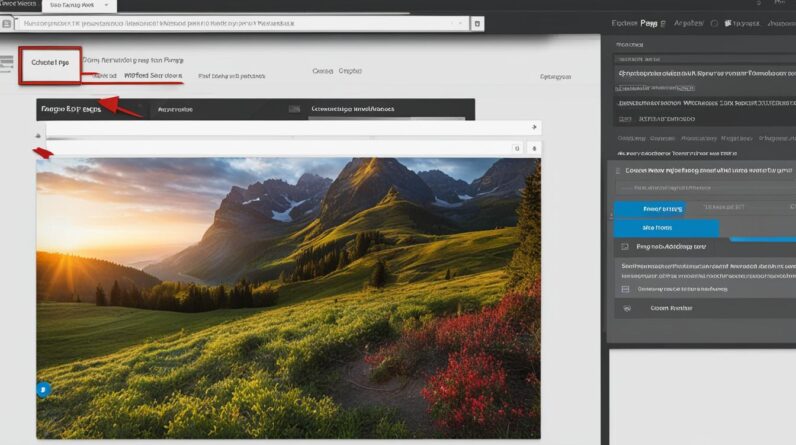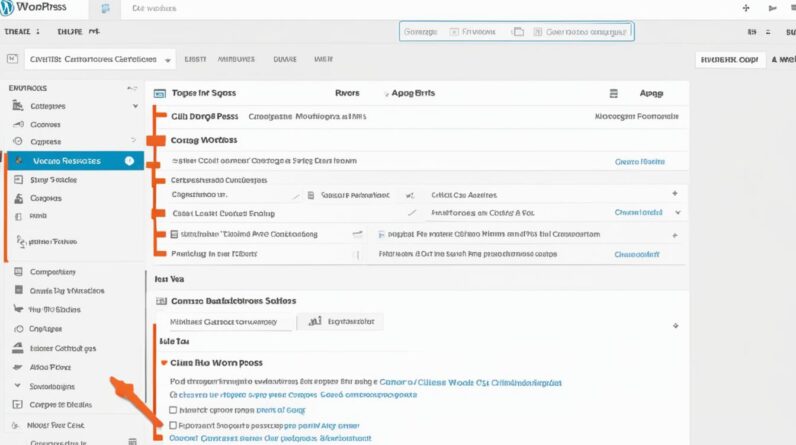Are you looking to set up a local WordPress development environment? Installing WordPress locally on your computer can provide you with a safe and efficient way to experiment with new features, plugins, and themes without impacting your live site. It also offers the convenience of working offline and allows you to continue your projects even without internet access. In this step-by-step guide, I will walk you through the process of installing WordPress locally on both Windows and macOS platforms.
How to Make Money with YouTube
Create an empire of automated video websites for multiple streams of income
Key Takeaways:
- Installing WordPress locally allows you to test new features, plugins, and themes without affecting your live site.
- Working on a local WordPress installation provides a safe environment for development and experimentation.
- You can work on your WordPress projects offline, making it ideal for freelance developers or those with limited internet access.
- Setting up a local WordPress environment requires meeting certain hardware and software requirements.
- Whether you’re using Windows or macOS, there are specific installation steps you need to follow to set up WordPress locally.
Overview of WordPress Local Development
WordPress local development is a process that involves setting up and running a WordPress site on your local computer. This allows you to create an offline WordPress site and provides a safe testing environment where you can experiment with new features, plugins, and themes without affecting your live site. It’s an essential workflow for developers who want to work offline and ensure the stability of their projects before deploying them to a live server.
To set up a local development environment for WordPress, you need to install a local server environment, PHP, and MySQL on your computer. The local server environment acts as a virtual server that mimics the functionality of a live server, enabling you to run WordPress locally. PHP is a programming language used by WordPress, while MySQL is a database management system where your website’s data is stored.
Once you have the necessary components installed, you can download the latest version of WordPress and install it locally. This creates a secure and efficient environment where you can develop and test your website’s functionalities, design, and performance without the risk of affecting your live site.
Setting up a local WordPress development environment offers several benefits. Working offline allows you to continue working on your website even without an internet connection, providing uninterrupted productivity. It also eliminates the risk of accidental changes or errors impacting your live site, as the testing environment is separate from the public-facing website.
To summarize, WordPress local development provides a safe and efficient space for testing new features, plugins, and themes. It allows you to work offline and ensures that any changes made to your website are thoroughly tested and refined before going live. With a local development environment, you have complete control over the testing and development process, enabling you to build a robust and reliable website.
| Benefits of WordPress Local Development |
|---|
| Allows offline work |
| Provides a safe testing environment |
| Enables testing of new features, plugins, and themes |
| Facilitates efficient development workflow |
Reasons to Install WordPress Locally
There are several reasons why you might want to install WordPress locally on your computer. Firstly, it provides a safe environment for testing new features, plugins, and themes without impacting your live site. This means you can experiment and make changes without the fear of breaking anything on your actual website.
In addition to the safe testing environment, installing WordPress locally offers better accessibility to your projects. With a local installation, you can work on your WordPress website anytime, anywhere, even without an internet connection. This is especially beneficial for freelance WordPress developers who may need to work in locations with limited internet access.
Furthermore, by installing WordPress locally, you can take advantage of the learning curve. Using WordPress in a local environment allows you to familiarize yourself with the platform, experiment with its features, and gain confidence before launching a live site. You can try out different themes, customize settings, and learn how different plugins work, all without affecting your actual website.
Benefits of Installing WordPress Locally:
- Safe testing environment for new features, plugins, and themes
- Better accessibility, even with limited internet access
- Opportunity to learn and experiment with the platform
If you’re ready to experience the benefits of installing WordPress locally, continue reading to learn about the system requirements and installation process.
System Requirements for a Localhost
To run WordPress locally on Windows or Mac, there are certain system requirements that need to be met. These requirements include both hardware and software components. Ensuring your system meets these requirements is essential for a smooth and efficient local WordPress installation.
Hardware Requirements
When it comes to hardware, it is recommended to have a minimum of 4GB RAM for optimal performance. In addition, having at least 1.5GB of disk space is necessary to accommodate the WordPress installation and any associated files and media.
Software Requirements
The software requirements for running WordPress locally include:
- PHP 7.4+ – This server-side scripting language is essential for executing WordPress functionality.
- MySQL 5.6+ or MariaDB 10.1+ – A database management system is necessary for storing and retrieving WordPress data.
- HTTPS Support – Enabling HTTPS ensures a secure connection when accessing your local WordPress site.
- Local Server Environment – Apache or Nginx are commonly used server environments that provide the necessary infrastructure for running WordPress locally.
These software requirements are minimum recommendations for running WordPress locally. However, for larger sites or custom environments, it is advisable to allocate more disk space for better performance and storage capabilities.
| Component | Minimum Requirement |
|---|---|
| RAM | 4GB |
| Disk Space | 1.5GB |
| PHP | 7.4+ |
| MySQL or MariaDB | 5.6+ or 10.1+ |
| HTTPS Support | Required |
| Local Server Environment | Apache or Nginx |
Meeting these system requirements ensures that your local WordPress installation can function properly and provide a seamless development and testing environment.
Installing WordPress on a Localhost
Setting up a local WordPress site involves installing the necessary components, including a web server, PHP, and a database. WordPress itself does not run directly on your local machine but requires a web server, PHP, and a database to create the environment in which it operates. The process typically consists of:
- Setting up the environment: Before installing WordPress, you need to have a web server (such as Apache or Nginx), a PHP installation, and a database server (such as MySQL or MariaDB) up and running on your computer.
- Downloading WordPress: Visit the official WordPress website and download the latest stable version of WordPress.
- Installing WordPress: Once you have downloaded WordPress, you can begin the installation process. This involves creating a database for WordPress, configuring the necessary settings, and setting up an admin account. The installation wizard will guide you through the process step by step.
By following these steps, you can successfully install WordPress on your local machine and start building and testing your website offline.
Installing WordPress on Windows
For users with the Windows operating system, installing WordPress is a straightforward process. By setting up and configuring a virtual host on Windows 10 using XAMPP, you can create a local development environment for your WordPress projects.
XAMPP is a popular software package that includes Apache as a web server and MySQL as the database, making it ideal for running WordPress locally. To install WordPress on Windows, follow these steps:
Step 1: Download XAMPP
Start by downloading XAMPP from the official website here. Choose the version compatible with your Windows operating system.
Step 2: Install XAMPP
Once the download is complete, locate the executable file and double-click on it to start the installation process. Follow the on-screen instructions to complete the installation.
Step 3: Configure XAMPP Control Panel
After installing XAMPP, launch the XAMPP Control Panel. Here, you can start and stop the Apache web server and MySQL database. You can also configure other settings related to your local development environment.
Step 4: Set Up a Virtual Host
Next, you’ll need to set up a virtual host to run WordPress. Open the “httpd-vhosts.conf” file located in the “apache” folder of your XAMPP installation directory. Add the following code to the file:
<VirtualHost *:80>
DocumentRoot "C:/xampp/htdocs/"
ServerName localhost
</VirtualHost>
<VirtualHost *:80>
DocumentRoot "C:/xampp/htdocs/wordpress"
ServerName wordpress.test
</VirtualHost>
In the above code, replace “C:/xampp/htdocs/” with the path to your XAMPP htdocs folder. This is where your WordPress files will be located. Also, change “wordpress.test” to the desired domain name for your local WordPress site.
Step 5: Download WordPress
Visit the official WordPress website here and download the latest stable version of WordPress. Once the download is complete, extract the files to the folder specified in the virtual host configuration (e.g., “C:/xampp/htdocs/wordpress”).
Step 6: Install WordPress
Finally, open your preferred web browser and enter the domain name you specified in the virtual host configuration (e.g., “http://wordpress.test”) to start the WordPress installation process. Follow the prompts to set up your site, including creating a database and entering your site details. Once the installation is complete, you can access your WordPress site by entering the domain name in your browser.
By following these steps, you can easily install and set up WordPress locally on your Windows operating system using XAMPP. Enjoy the benefits of a local development environment and start building your WordPress projects with ease.
Installing WordPress on macOS
If you are using a Mac computer, you can easily install WordPress locally by setting up a web server and database using MAMP.
MAMP is a comprehensive software package that provides everything you need to run a local development environment on macOS. With MAMP, you can create a secure and efficient setup to install and work with WordPress on your Mac.
Setting Up MAMP for Local Development
- Download MAMP from the official website
- Install MAMP on your Mac
- Configure the MAMP control panel
- Set up the web server and database
Once you have successfully installed and configured MAMP, you can proceed to download WordPress and install it locally on your Mac.
Downloading WordPress and Installing Locally
- Go to the official WordPress website and download the latest version
- Extract the downloaded WordPress files
- Copy the extracted files to the “htdocs” folder in the MAMP installation directory
- Access the MAMP control panel and start the MAMP servers
- Open your web browser and enter “localhost” in the address bar
- Follow the WordPress installation wizard to complete the setup
Once the installation is complete, you can start using WordPress locally on your Mac. Simply access your local site through the browser and begin building and customizing your WordPress website.
Installing WordPress on macOS using MAMP provides a convenient and efficient way to create a local development environment for your WordPress projects. Whether you are a developer, designer, or WordPress enthusiast, setting up WordPress locally on your Mac allows you to experiment, learn, and build without affecting your live website.
Creating Staging for Local Development
Creating a staging environment is crucial for local development as it allows you to test changes to your website before making them live. This helps you avoid potential errors and saves time and effort in the long run. Fortunately, hosting providers like Cloudways offer a convenient solution with their 1-click staging environment feature.
Benefits of a Staging Environment
Having a staging environment offers several advantages:
- Testing Changes: You can experiment with new plugins, themes, and features, ensuring they work seamlessly before implementing them on your live website.
- Error-Free Deployment: By testing changes in a staging environment, you can detect and fix any issues or conflicts before they impact your live website.
- Enhanced Security: Staging environments are private and password-protected replicas of your website, ensuring that testing remains confidential and unauthorized users cannot access it.
- Efficient Workflow: With a staging environment, you can streamline your development process by making updates, testing them, and then deploying them to your live website, reducing downtime and improving productivity.
Cloudways 1-Click Staging Environment
Cloudways, a leading managed cloud hosting platform, offers a convenient 1-click staging environment feature. This allows you to quickly create a private and password-protected replica of your website, exclusively for testing purposes.
By utilizing Cloudways’ staging environment, you can confidently test and validate changes, such as theme modifications, plugin updates, or even major website redesigns, all without the risk of affecting your live website. This ensures a seamless user experience for your visitors and minimizes the chances of any downtime or disruption.
Cloudways’ staging environment enables you to:
- Easily clone your live website to a staging environment with just a single click.
- Securely test changes and updates without interfering with your live website.
- Perform thorough quality assurance testing before deploying changes to your live website.
- Effortlessly synchronize your staging and live websites to ensure consistency.
With Cloudways’ intuitive interface and powerful infrastructure, you can create a staging environment in minutes and begin testing changes in a secure and controlled setting. This eliminates the need for complex manual setups and saves valuable time that can be better utilized in developing your website.
| Staging Environment Benefits | Cloudways Staging Environment Features |
|---|---|
| Testing Changes | One-click replication of your live website |
| Error-Free Deployment | Private and password-protected replica |
| Enhanced Security | Secure testing environment |
| Efficient Workflow | Easy synchronization between staging and live websites |
Optimizing Your WordPress Installation
Once you have installed WordPress locally, it’s essential to optimize its performance to ensure a smooth user experience. By implementing various optimization techniques, you can enhance the loading speed and overall efficiency of your WordPress site. Here are some key strategies to optimize your WordPress installation:
Caching
Enabling caching is an effective way to improve website performance. By caching frequently accessed content, your site can deliver pages more quickly, reducing server load and enhancing the user experience. There are several caching plugins available for WordPress, such as W3 Total Cache and WP Rocket, which can handle caching automatically.
Minification
Minifying CSS (Cascading Style Sheets) and JavaScript files can significantly reduce their file size, leading to faster page load times. Minification removes unnecessary characters, whitespace, and comments from your code without affecting its functionality. Plugins like Autoptimize and WP Super Minify can automatically minify your site’s CSS and JavaScript files.
Image Optimization
Optimizing images is crucial for improving website performance. Compressing images reduces their file size without sacrificing quality, resulting in faster loading times. You can use plugins like Smush or Imagify to automatically optimize and compress images on your WordPress site.
Using Efficient Plugins
Choose plugins that are well-coded and optimized for performance. Poorly-coded or resource-intensive plugins can significantly impact your site’s loading speed. Before installing a plugin, check its reviews and ratings and ensure it is compatible with your WordPress version. Additionally, regularly update your plugins to benefit from the latest performance improvements and bug fixes.
By implementing these optimization techniques, you can significantly enhance the performance of your WordPress installation. This will result in faster loading times, improved user experience, and better search engine rankings. Don’t forget to monitor your site’s performance regularly and make necessary adjustments to maintain optimal performance.
Troubleshooting Errors of Local Installation
Like any software installation, there may be times when you encounter errors or issues with your local WordPress installation. These errors can disrupt your workflow and hinder progress, but fear not! With a few troubleshooting techniques, you can quickly identify and resolve common problems, ensuring your local WordPress installation is running smoothly.
Debug Mode
One useful tool for troubleshooting WordPress errors is the debug mode. By enabling debug mode, you can retrieve detailed information about any errors that occur, helping you pinpoint the root cause. To enable debug mode, simply locate your wp-config.php file, typically found in the root directory of your WordPress installation, and add the following line of code:
define('WP_DEBUG', true);Once enabled, errors and warnings will be displayed on your screen, providing valuable insights into any issues present. Remember to disable debug mode once troubleshooting is complete to prevent sensitive information from being exposed.
Error Logs
Another valuable troubleshooting resource is the error logs. Error logs help to track and monitor errors that may occur during your local WordPress installation. To access the error logs, you can check the server logs or consult the documentation provided by your local server environment.
Common errors you may encounter during a local WordPress installation include the notorious “white screen of death,” which indicates a fatal error that prevents your site from loading, plugin conflicts that arise when incompatible plugins clash with each other or with your WordPress installation, and database connection errors that occur when there are issues with the connection to your local database.
By reviewing the error logs and analyzing the error messages, you can gain insights into the nature of the errors and take appropriate actions to resolve them.
Common Errors and Solutions
To assist you in troubleshooting, here are some common errors encountered during local WordPress installations and their potential solutions:
| Error | Solution |
|---|---|
| White screen of death | This error is often caused by a PHP error or a memory limit issue. To resolve it, try disabling recently installed plugins or themes. If the error persists, increasing the memory limit in your wp-config.php file may help. |
| Plugin conflicts | If you encounter issues after installing or activating a plugin, try disabling the plugin and checking if the problem resolves. If it does, the plugin may be causing conflicts with your local WordPress installation. Consider updating the plugin or seeking an alternative. |
| Database connection errors | Ensure that the database credentials in your wp-config.php file are correctly configured. Verify the database server, username, password, and database name. If the credentials are correct, check if the database server is running or if there are any network issues. |
By addressing these common errors and referring to the error logs and debug mode, you can troubleshoot and resolve issues encountered during your local WordPress installation. Remember, persistence and a systematic approach will help you conquer any challenge that comes your way!

Conclusion
Installing WordPress locally offers numerous benefits for developers and website owners alike. It provides a safe testing environment where you can freely experiment with new features, plugins, and themes without impacting your live site. Additionally, working offline allows you to continue your projects even without an internet connection, ensuring uninterrupted productivity.
By following the step-by-step installation process for Windows or macOS, you can easily set up a local development environment and take advantage of its efficiency. With the ability to work offline, you can focus on your tasks without distractions and create an efficient workflow that maximizes your productivity.
In conclusion, installing WordPress locally not only ensures a safe testing environment but also enables you to work offline and achieve an efficient workflow. By setting up a local development environment, you can enjoy the benefits of offline work, experiment freely, and optimize your WordPress projects before going live. So, why wait? Install WordPress locally today and revolutionize your web development experience.
FAQ
How do I install WordPress locally on my computer?
To install WordPress locally, you need to set up a local server environment, install PHP and MySQL, download the latest version of WordPress, and install it on your computer. Detailed step-by-step instructions can be found in the guide above.
Why should I install WordPress locally?
Installing WordPress locally provides a safe environment for testing new features, plugins, and themes without impacting your live site. It also allows you to work offline and continue your projects even without internet access. Additionally, it can be a great way to learn how to use WordPress and experiment with its features before launching a live site.
What are the system requirements for running WordPress locally?
The minimum system requirements for running WordPress locally include a minimum of 4GB RAM and 1.5GB disk space. You also need to have PHP 7.4+, MySQL 5.6+ or MariaDB 10.1+, HTTPS support, and a local server environment such as Apache or Nginx. More disk space is recommended for larger sites or custom environments.
How can I install WordPress on a Windows computer?
To install WordPress on Windows, you can use XAMPP, which includes Apache as a web server and MySQL as the database. The installation process involves downloading and installing XAMPP, configuring the XAMPP control panel, and setting up the necessary components to run WordPress locally.
What is the process of installing WordPress on macOS?
On macOS, you can install WordPress by using MAMP, a software package that includes everything you need to run a local development environment. After downloading and installing MAMP, you need to configure the MAMP control panel and set up a web server and database to run WordPress locally.
Can I create a staging environment for my local WordPress development?
Yes, you can create a staging environment for your local development. Some hosting providers, such as Cloudways, offer a free 1-click staging environment, allowing you to quickly create a private and password-protected replica of your website to test changes without affecting your live site.
How can I optimize the performance of my locally installed WordPress?
To optimize the performance of your locally installed WordPress, you can enable caching, minify CSS and JavaScript files, optimize images, and use efficient plugins. These steps can improve loading speed and overall performance, providing a better user experience.
What should I do if I encounter errors during my local WordPress installation?
If you encounter errors during your local WordPress installation, you can enable debug mode and check the error logs. This will help you troubleshoot and resolve any issues that may arise, ensuring your local WordPress installation runs smoothly.
What are the benefits of installing WordPress locally?
Installing WordPress locally provides a safe and efficient environment for testing and development. It allows you to experiment with new features, plugins, and themes without affecting your live site. Working offline and continuing projects even without internet access is another advantage. Overall, it offers an efficient workflow for WordPress development.






